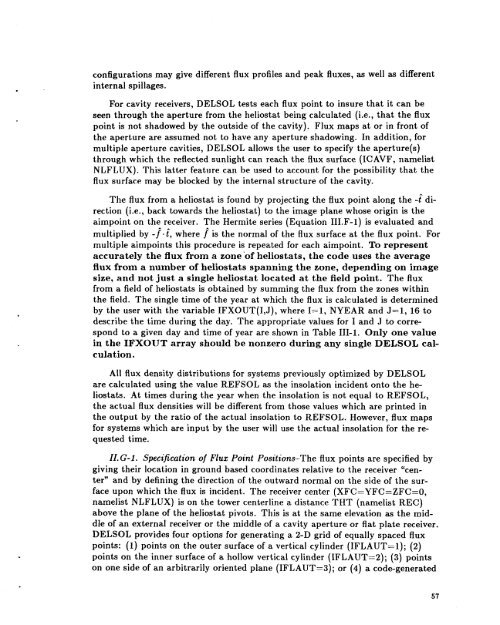A User's Manual for DELSOL3 - prod.sandia.gov - Sandia National ...
A User's Manual for DELSOL3 - prod.sandia.gov - Sandia National ...
A User's Manual for DELSOL3 - prod.sandia.gov - Sandia National ...
Create successful ePaper yourself
Turn your PDF publications into a flip-book with our unique Google optimized e-Paper software.
,<br />
configurations may give different flux profiles and peak fluxes, as well as different<br />
internal spillages.<br />
For cavity receivers, DELSOL tests each flux point to insure that it can be<br />
seen through the aperture from the heliostat being calculated (i.e., that the flux<br />
point is not shadowed by the outside of the cavity). Flux maps at or in front of<br />
the aperture are assumed not to have any aperture shadowing. In addition, <strong>for</strong><br />
multiple aperture cavities, DELSOL allows the user to specify the aperture(s)<br />
through which the reflected sunlight can reach the flux surface (ICAVF, namelist<br />
NLFLUX). This latter feature can be used to account <strong>for</strong> the possibility that the<br />
flux surface may be blocked by the internal structure of the cavity.<br />
The flux from a heliostat is found by projecting the flux point along the -t^ direction<br />
(i.e., back towards the heliostat) to the image plane whose origin is the<br />
aimpoint on the receiver. The Hermite series (Equation 1II.F-1) is evaluated and<br />
multiplied by -f-i, where is the normal of the flux surface at the flux point. For<br />
multiple aimpoints this procedure is repeated <strong>for</strong> each aimpoint. To represent<br />
accurately the flux from a zone’of heliostats, the code uses the average<br />
flux from a number of heliostats spanning the zone, depending on image<br />
size, and not just a single heliostat located at the field point. The flux<br />
from a field of heliostats is obtained by summing the flux from the zones within<br />
the field. The single time of the year at which the flux is calculated is determined<br />
by the user with the variable IFXOUT(I,J), where I=l, NYEAR and J=1, 16 to<br />
describe the time during the day. The appropriate values <strong>for</strong> I and J to correspond<br />
to a given day and time of year are shown in Table 111-1. Only one value<br />
in the IFXOUT array should be nonzero during any single DELSOL calculat<br />
ion.<br />
All flux density distributions <strong>for</strong> systems previously optimized by DELSOL<br />
are calculated using the value REFSOL as the insolation incident onto the he-<br />
liostats. At times during the year when the insolation is not equal to REFSOL,<br />
the actual flux densities will be different from those values which are printed in<br />
the output by the ratio of the actual insolation to REFSOL. However, flux maps<br />
<strong>for</strong> systems which are input by the user will use the actual insolation <strong>for</strong> the re-<br />
quested time.<br />
ll.G-I. Specification of Flux Point Positions-The flux points are specified by<br />
giving their location in ground based coordinates relative to the receiver “cen-<br />
ter’’ and by defining the direction of the outward normal on the side of the sur-<br />
face upon which the flux is incident. The receiver center (XFC=YFC=ZFC=O,<br />
namelist NLFLUX) is on the tower centerline a distance THT (namelist REC)<br />
above the plane of the heliostat pivots. This is at the same elevation as the mid-<br />
dle of an external receiver or the middle of a cavity aperture or flat plate receiver.<br />
DELSOL provides four options <strong>for</strong> generating a 2-D grid of equally spaced flux<br />
points: (1) points on the outer surface of a vertical cylinder (IFLAUT=l); (2)<br />
points on the inner surface of a hollow vertical cylinder (IFLAUT=2); (3) points<br />
on one side of an arbitrarily oriented plane (IFLAUT=S); or (4) a code-generated<br />
57

















